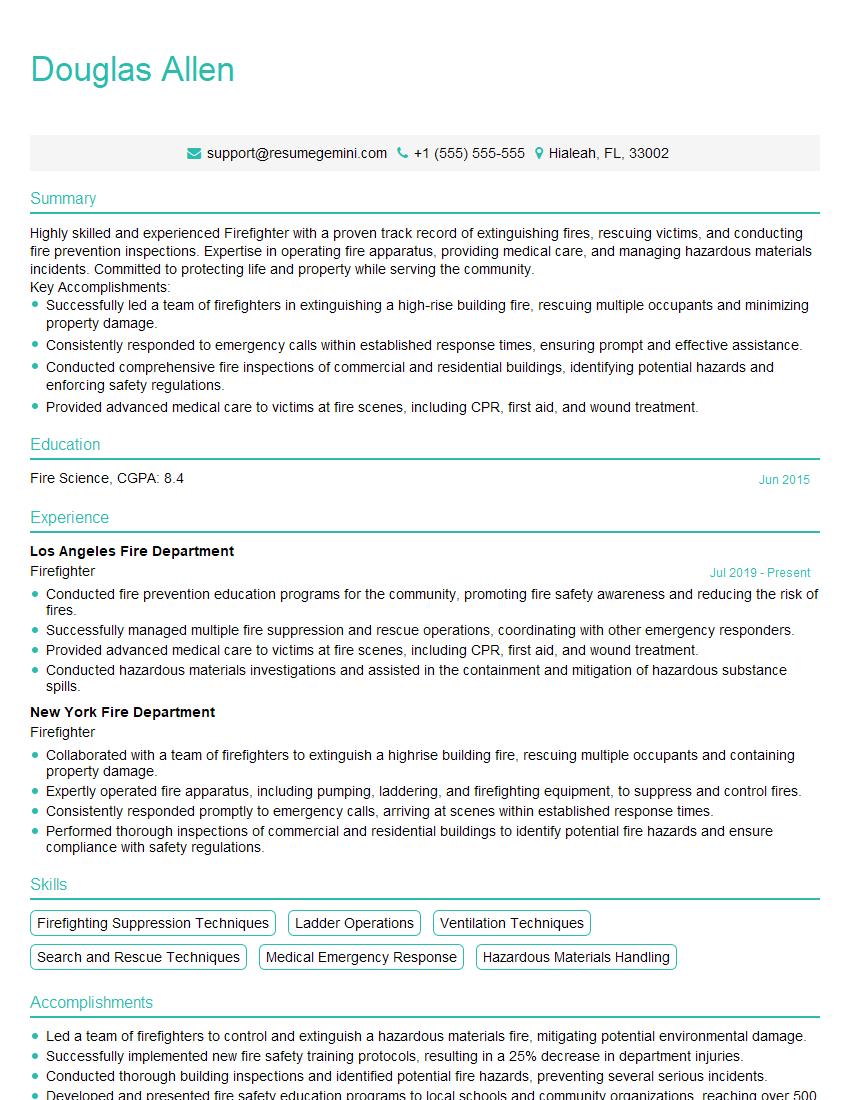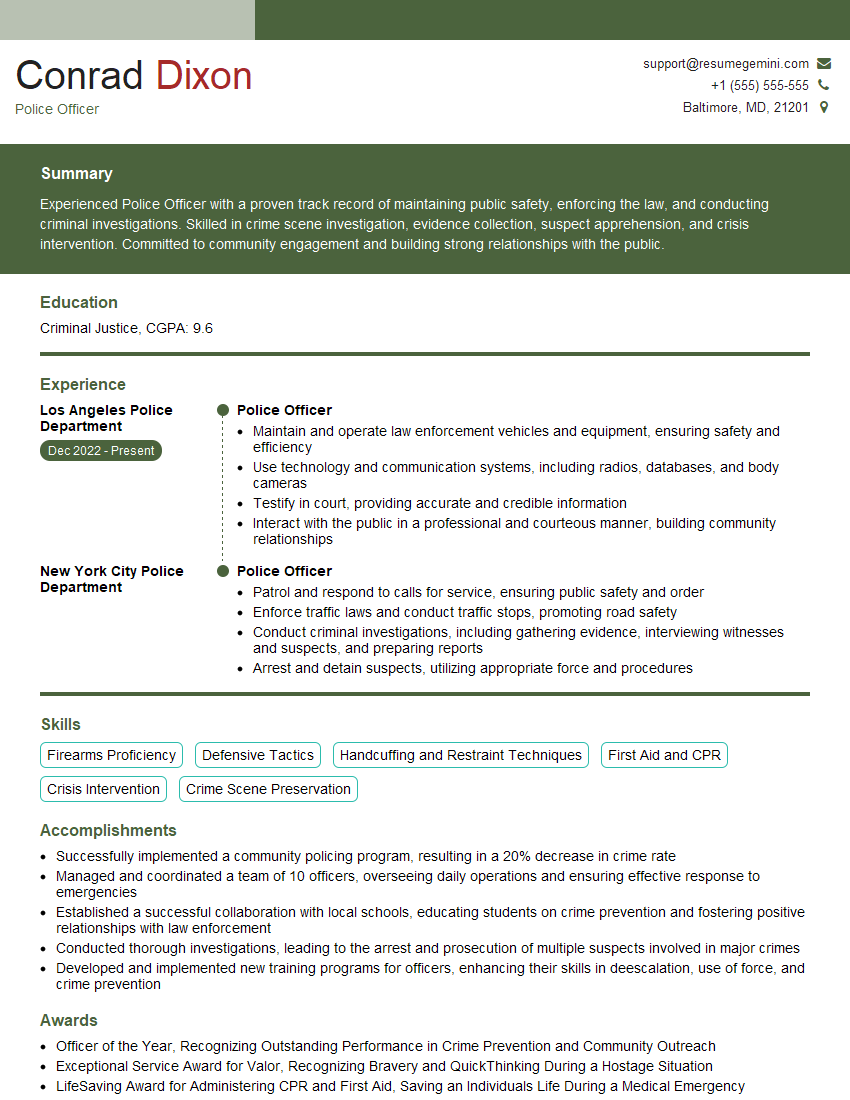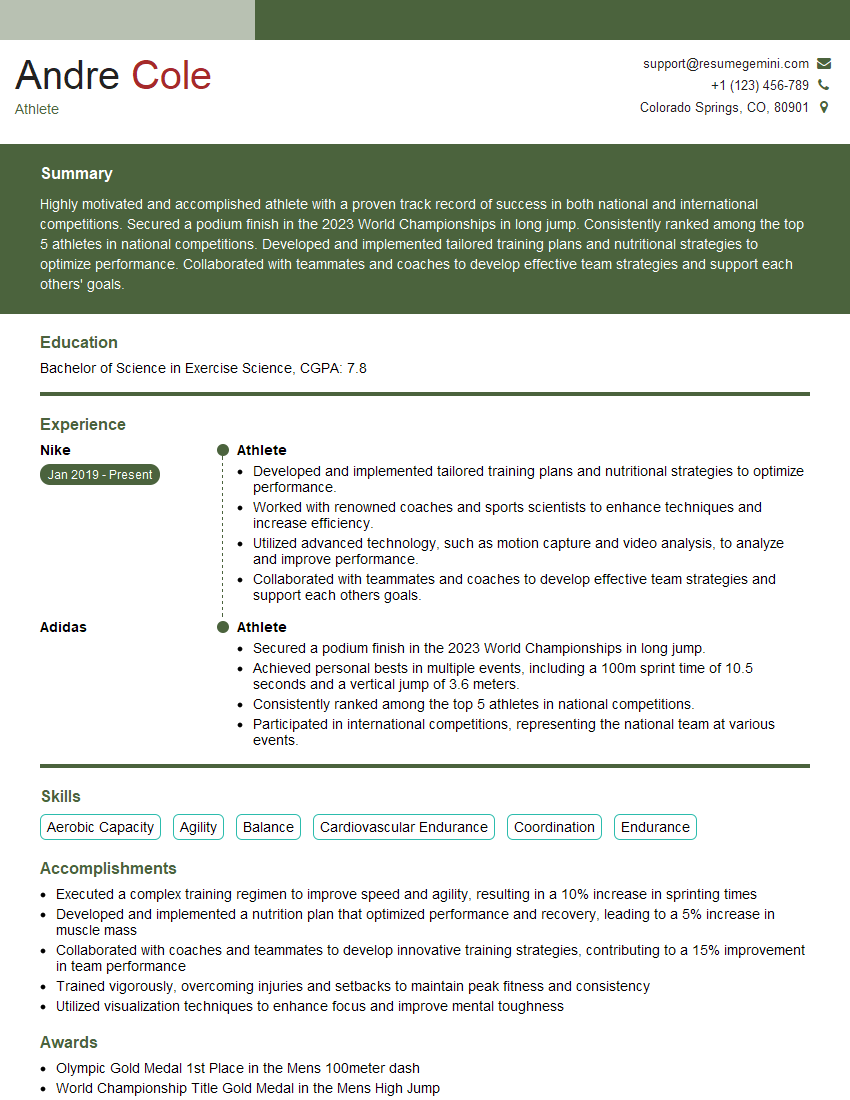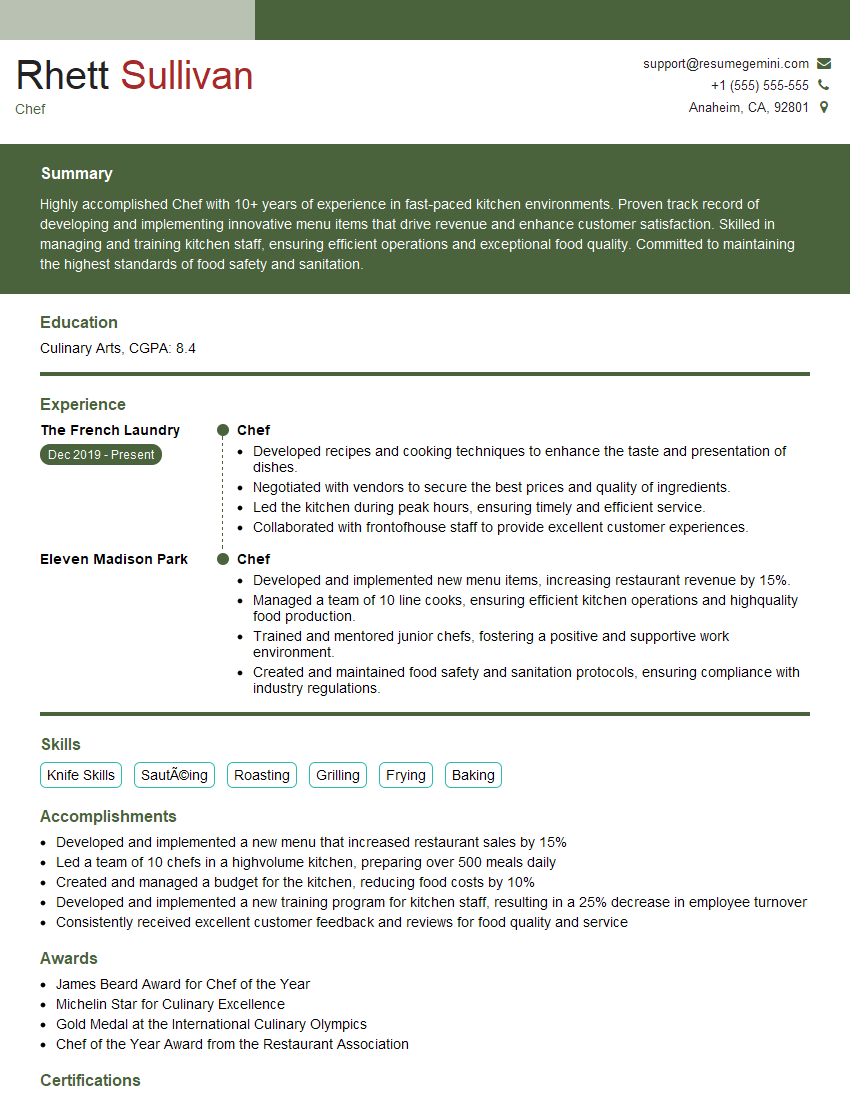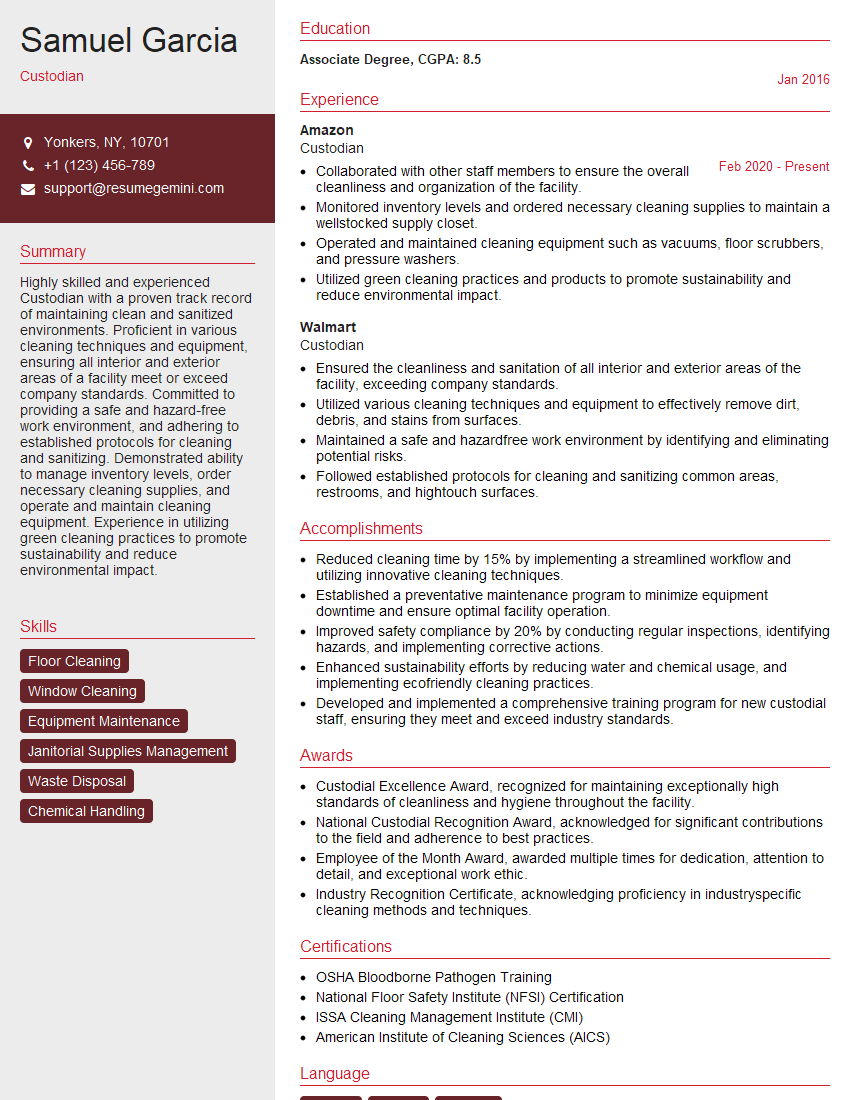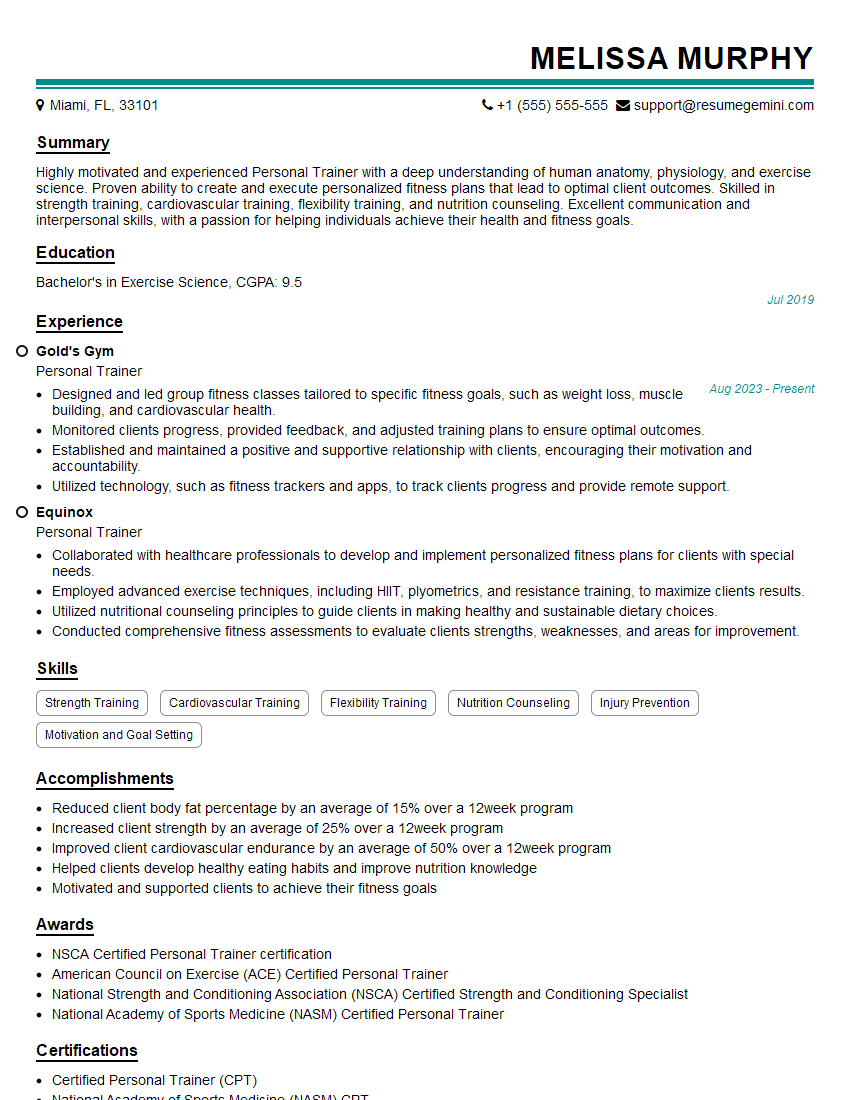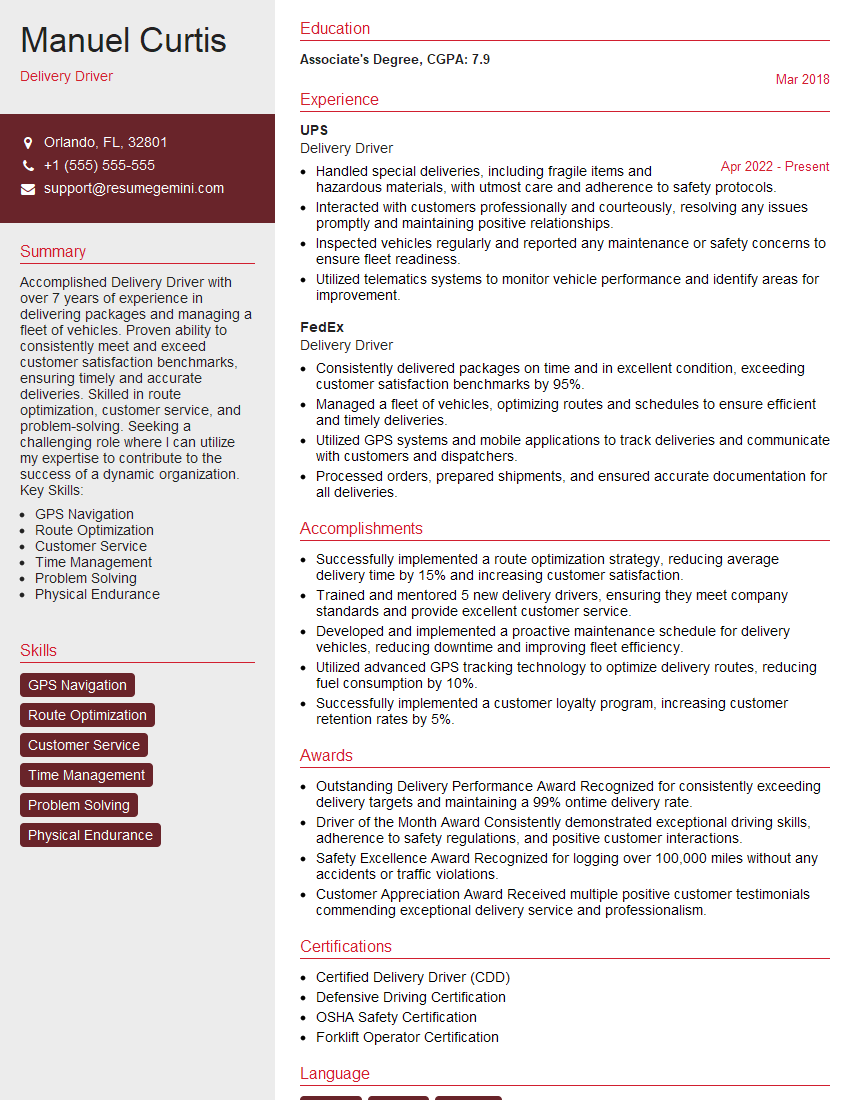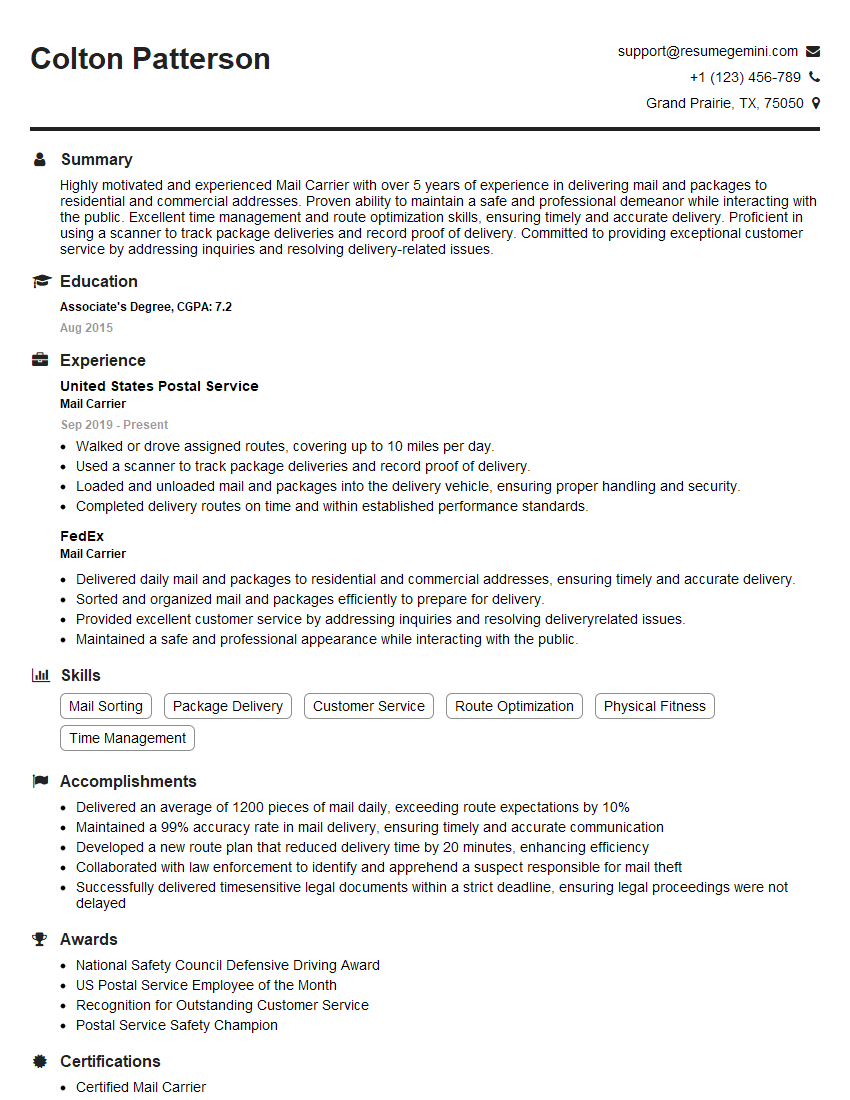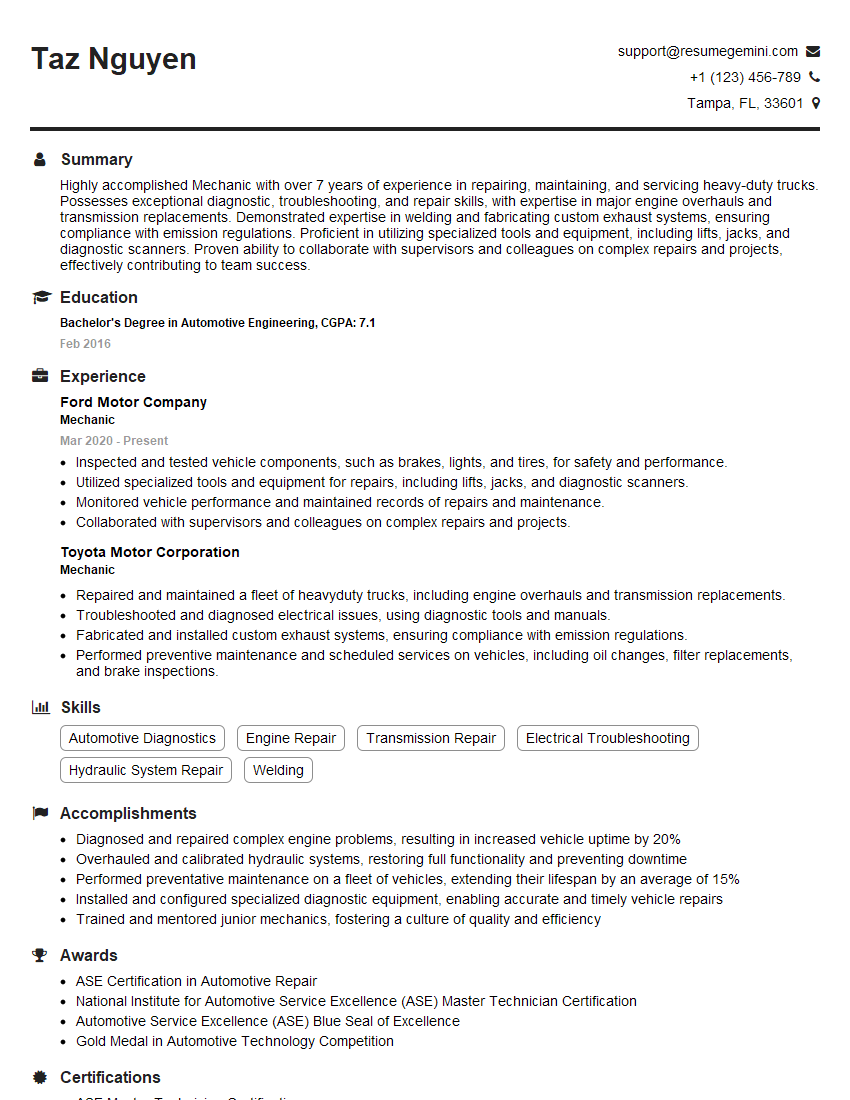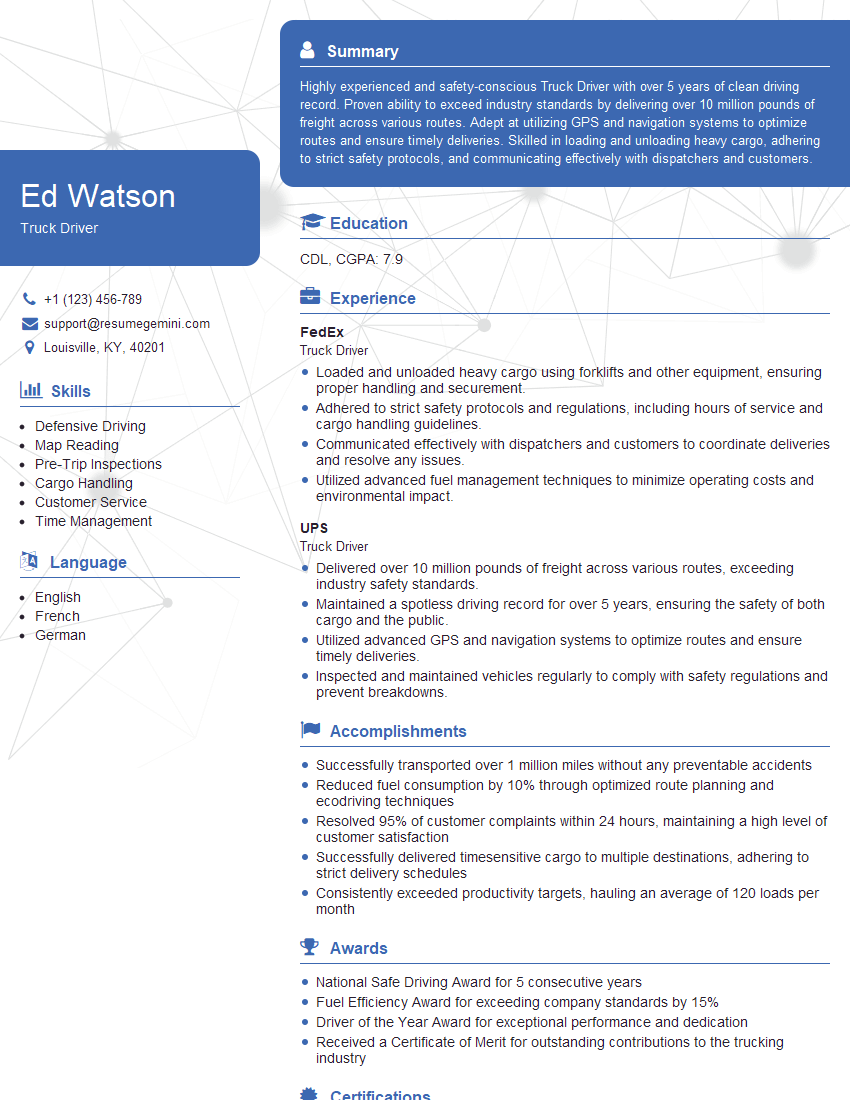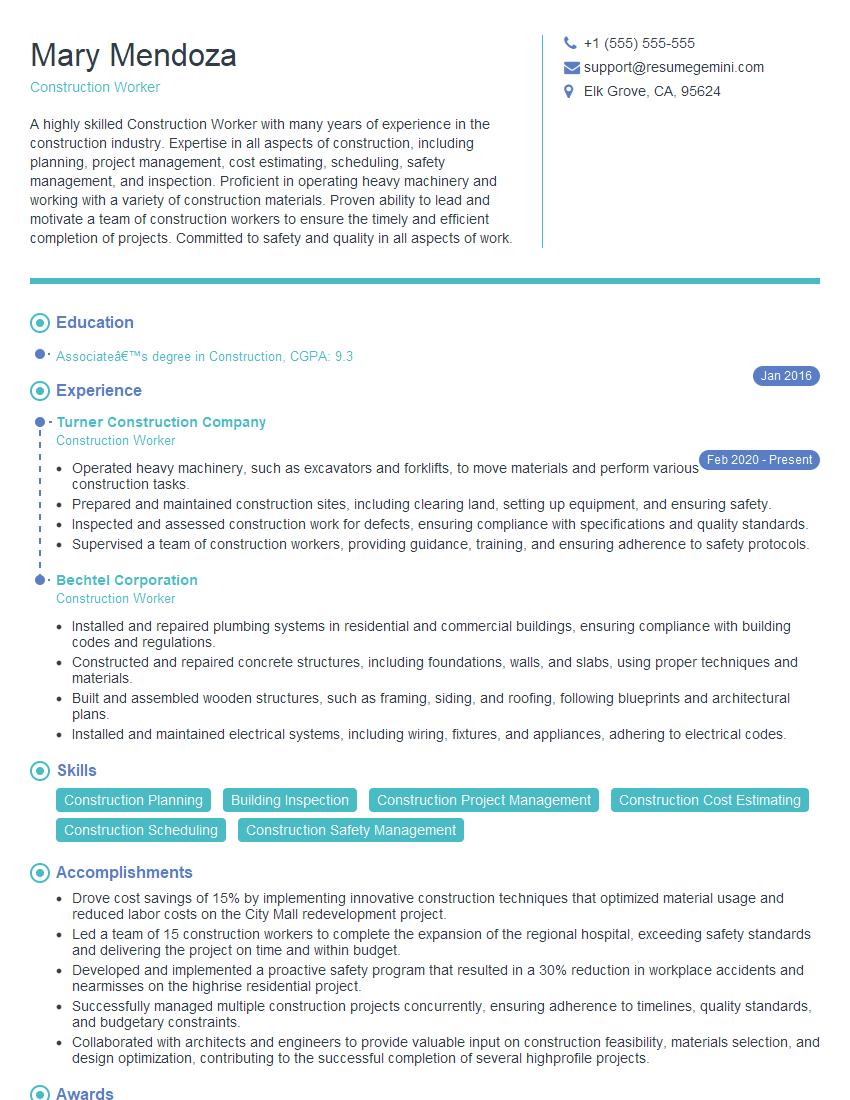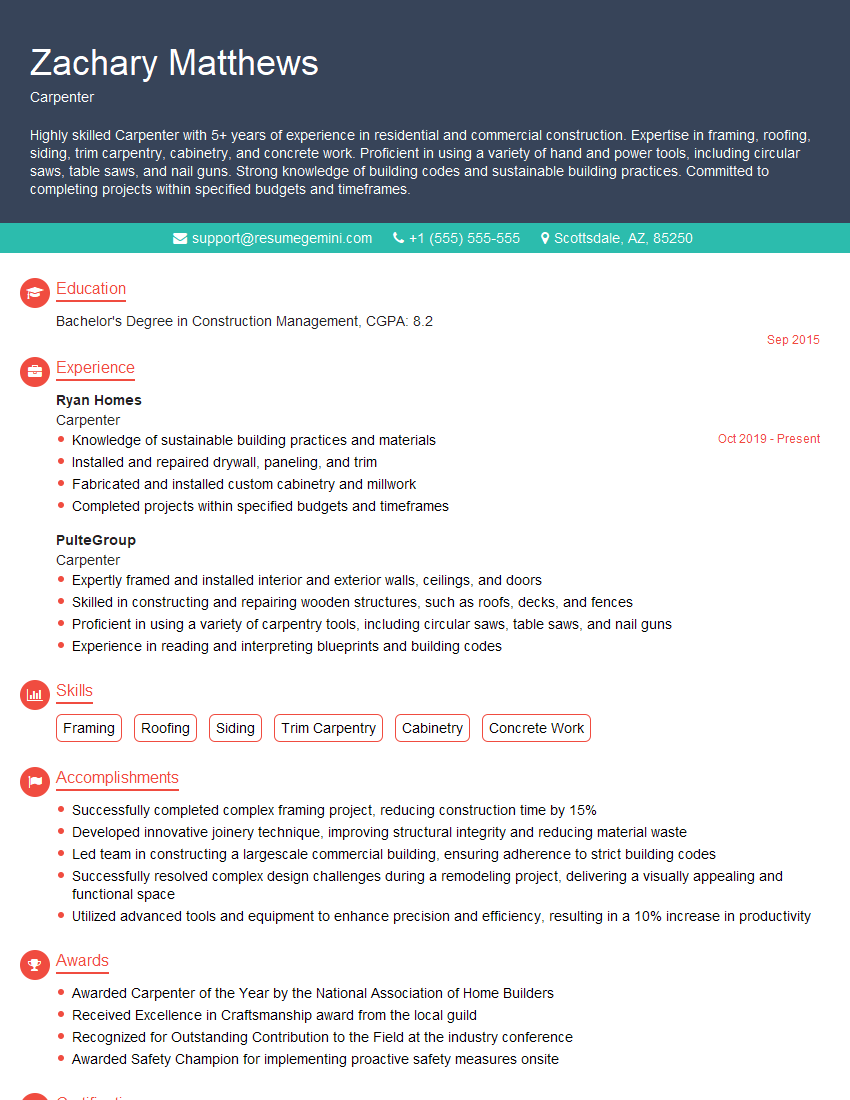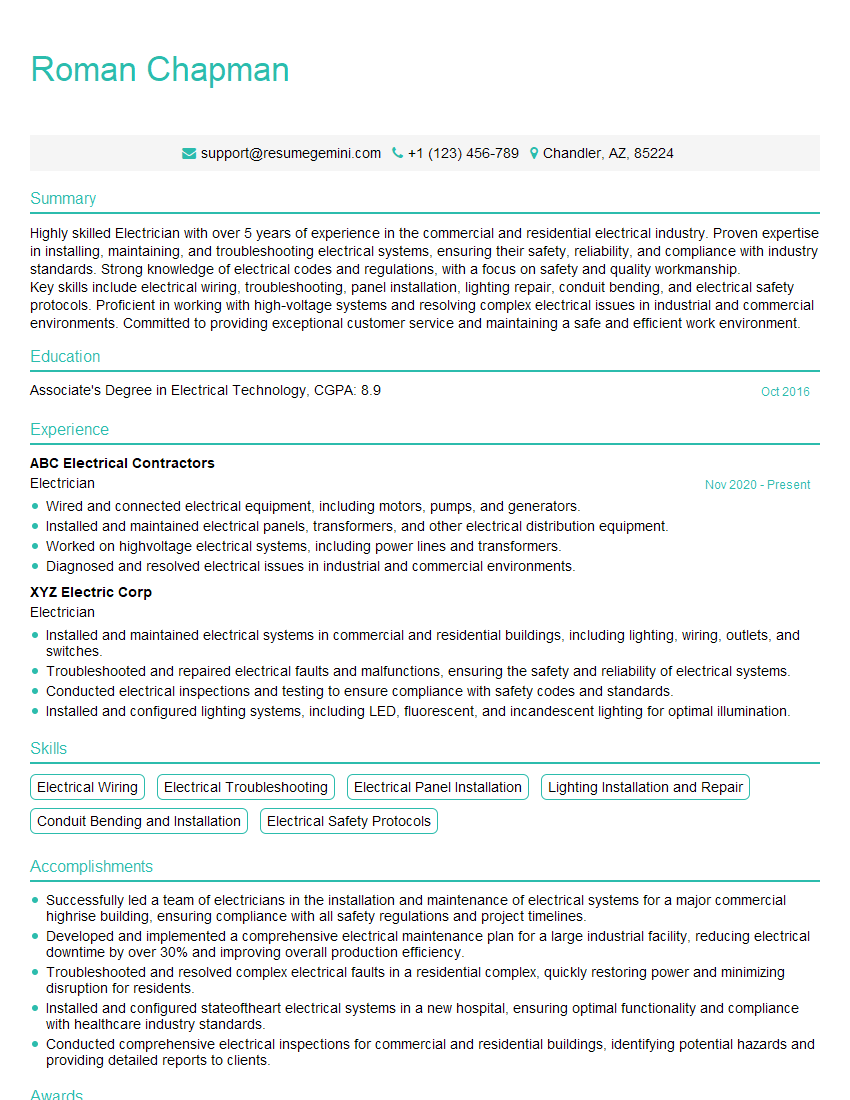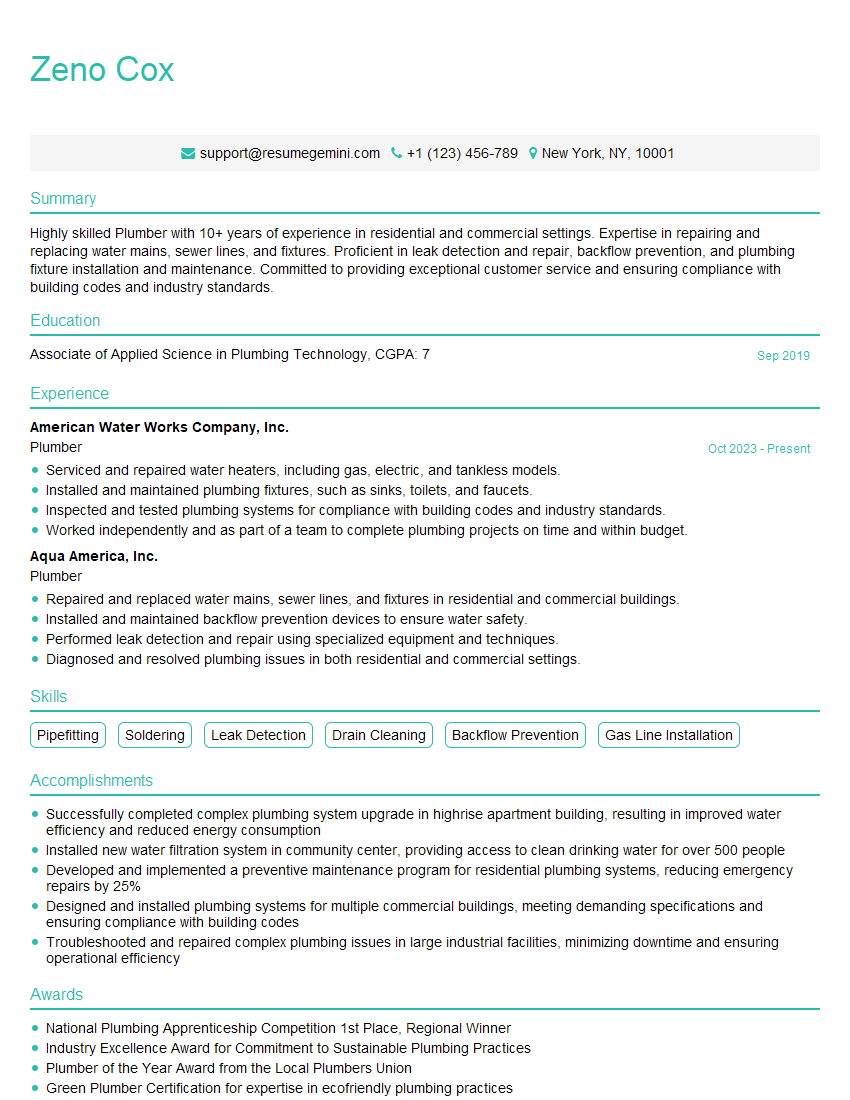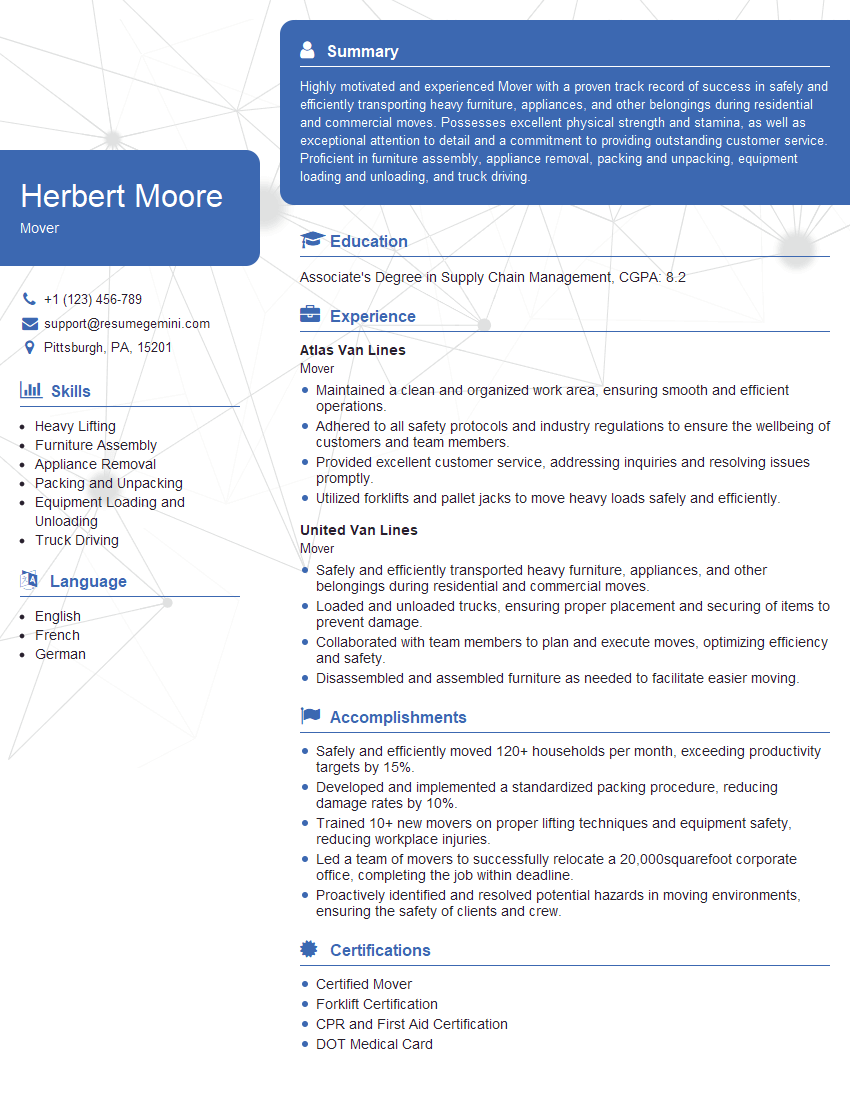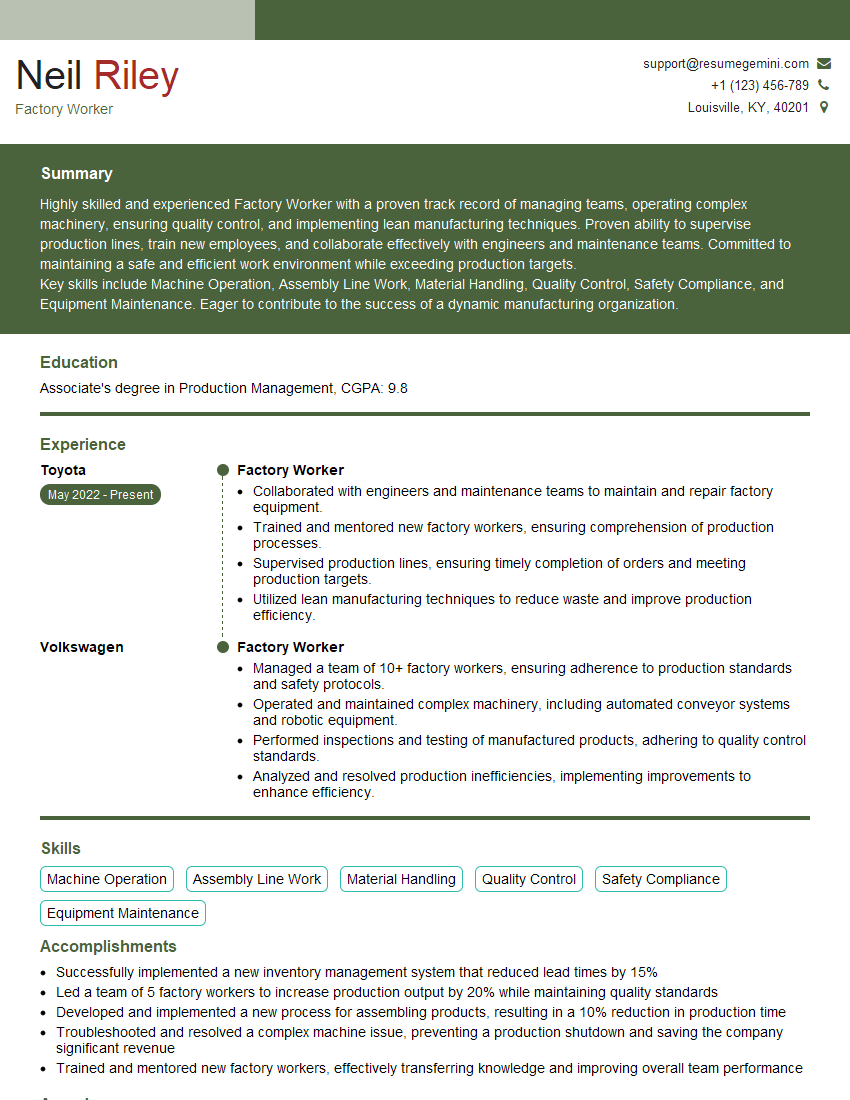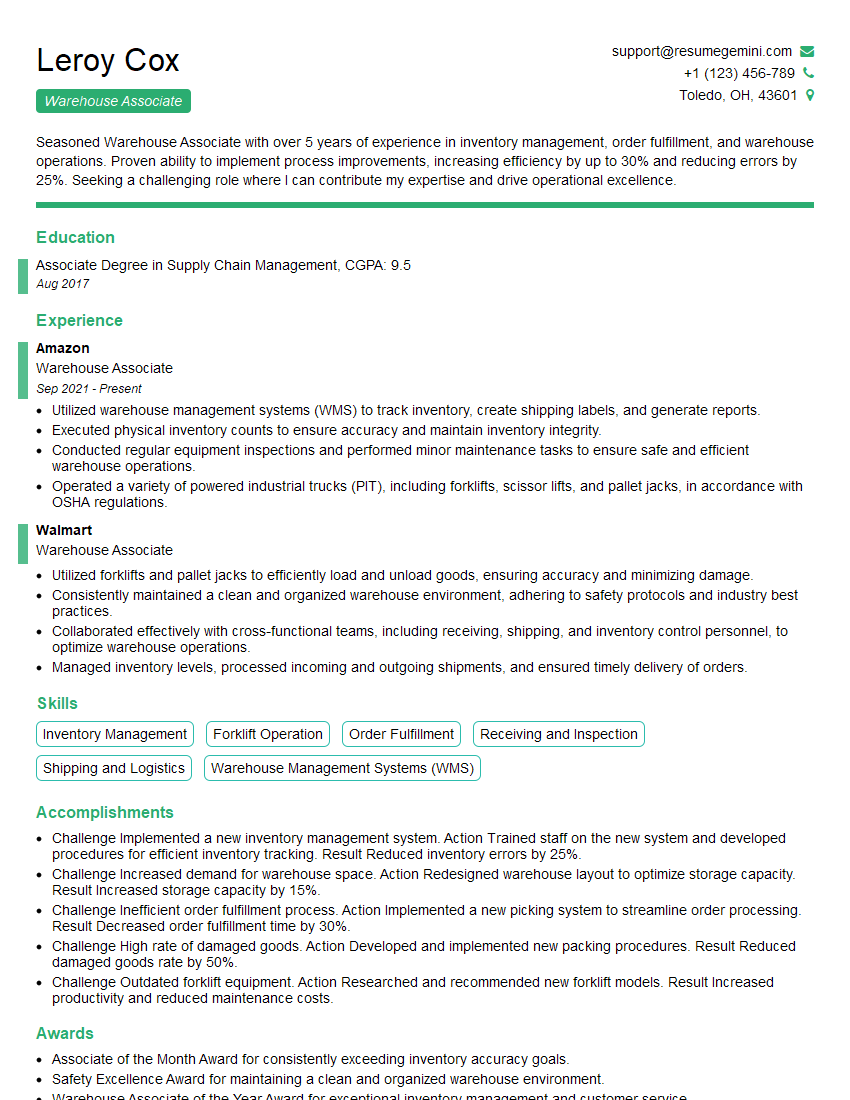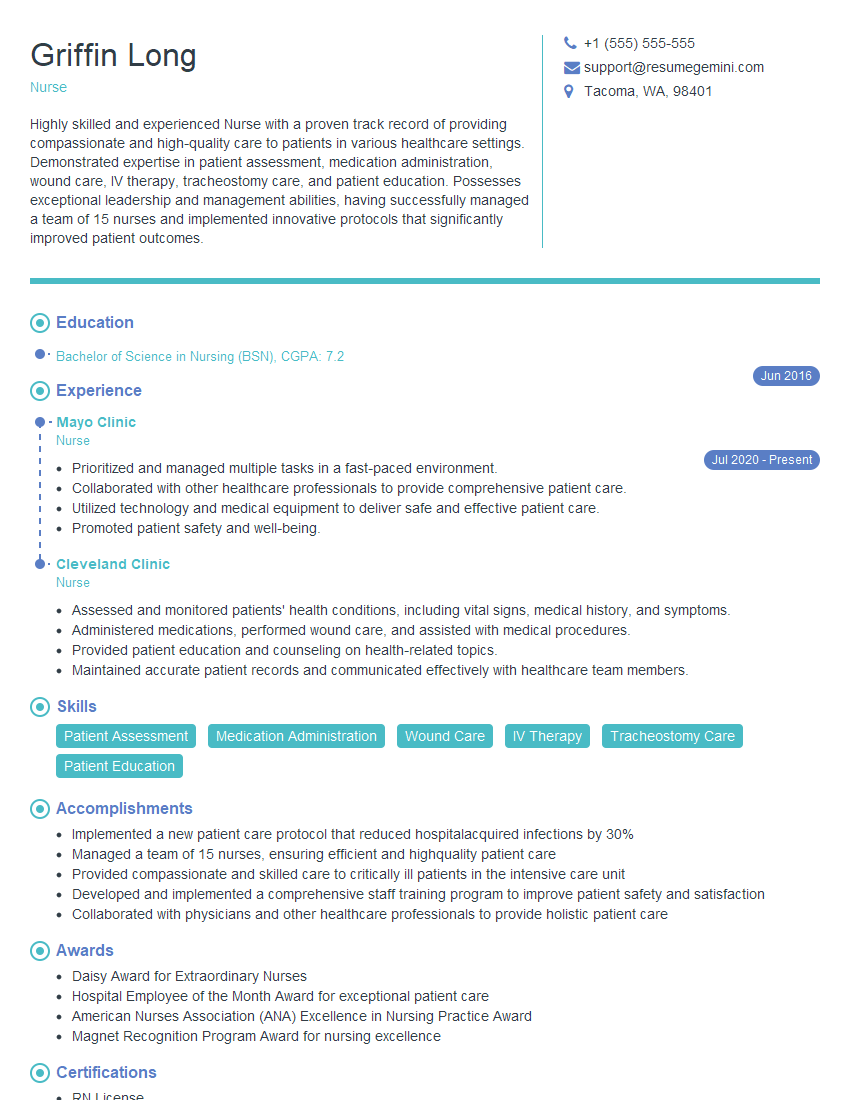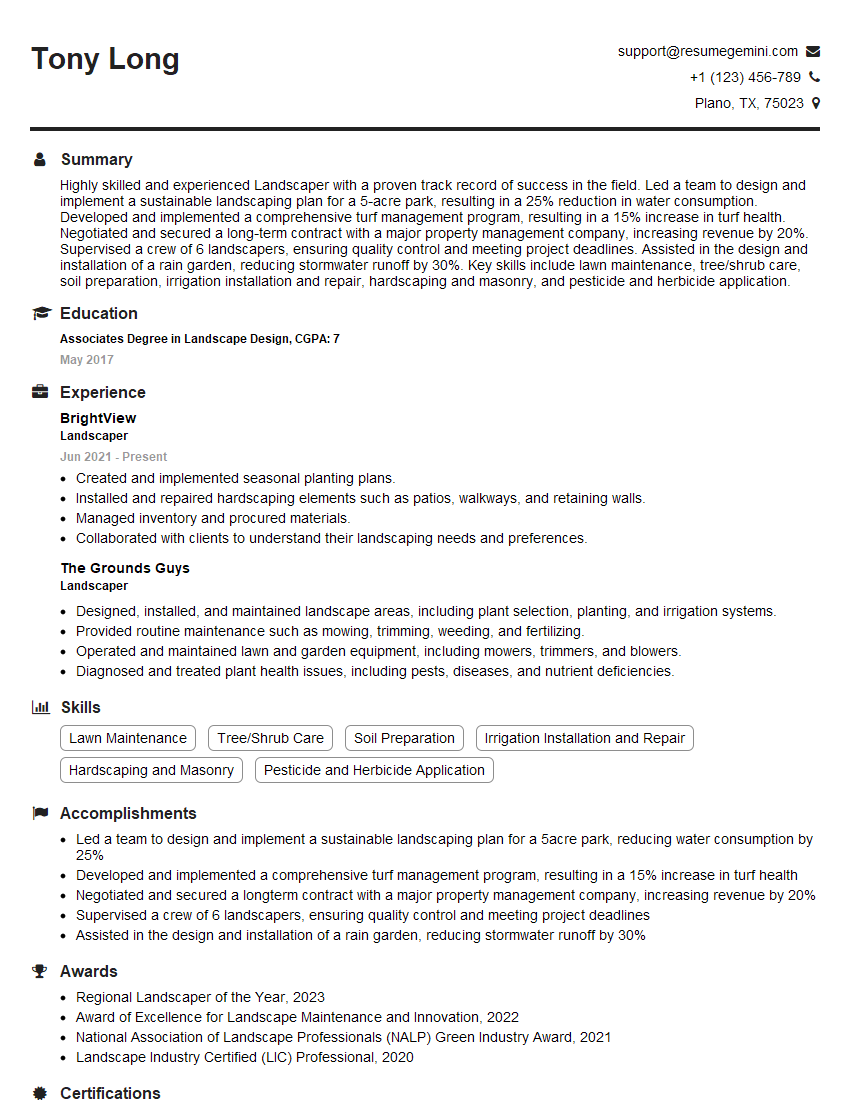The right preparation can turn an interview into an opportunity to showcase your expertise. This guide to Ability to Handle Physical Demands of the Job interview questions is your ultimate resource, providing key insights and tips to help you ace your responses and stand out as a top candidate.
Questions Asked in Ability to Handle Physical Demands of the Job Interview
Q 1. Describe your experience lifting heavy objects. What is your maximum comfortable lifting weight?
Throughout my career, I’ve consistently handled a variety of physically demanding tasks. My experience includes everything from moving furniture and equipment in a warehouse setting to assisting with patient transfers in a healthcare environment. My maximum comfortable lifting weight is 50 pounds, although I always prioritize proper lifting techniques to mitigate strain, regardless of the weight. For heavier objects, I always utilize appropriate lifting equipment and/or seek assistance from colleagues to ensure safe and efficient handling. This approach is crucial for preventing injuries and maintaining workplace safety.
For instance, during my time at [Previous Company Name], I frequently moved heavy boxes weighing between 30 and 40 pounds. I always adhered to proper lifting techniques – keeping my back straight, bending at the knees, and lifting with my legs. This proactive approach prevented any back injuries despite the repetitive nature of the task.
Q 2. How do you manage physical fatigue during long workdays?
Managing physical fatigue during long workdays is paramount for both productivity and health. My strategy involves a multi-pronged approach. Firstly, I maintain consistent hydration throughout the day by keeping water readily available. Secondly, I incorporate short, planned breaks to stretch and move around. Even a 5-minute break every hour can significantly reduce muscle fatigue. Thirdly, I prioritize proper posture and ergonomics to reduce unnecessary strain on my body. This might involve adjusting my workstation or taking mindful breaks to readjust my position. Lastly, I maintain a healthy diet and prioritize sufficient sleep to ensure my body has the energy to handle the demands of a long workday. I find that even small changes in these areas make a huge difference in my ability to sustain energy levels.
Q 3. Have you ever experienced a work-related injury? How did you handle it?
Yes, I once sustained a minor strain while lifting a heavy piece of equipment. The incident highlighted the importance of following safety protocols even when feeling confident in my abilities. I immediately reported the injury to my supervisor and sought medical attention. This resulted in a prompt diagnosis and a short period of recovery, during which I was provided with modified duties. I learned a valuable lesson about the necessity of being vigilant and seeking help when needed. The experience also strengthened my commitment to safety procedures and risk assessment.
Following the incident, I actively participated in workplace safety training, focusing particularly on proper lifting techniques and risk assessment. This proactive approach has ensured a similar incident hasn’t recurred.
Q 4. Describe your experience with repetitive movements. How do you avoid injuries from this?
Repetitive movements are a significant source of workplace injuries. My experience has shown me the importance of mitigating the risks through careful planning and mindful movement. I regularly incorporate micro-breaks to change postures and stretch affected muscle groups. I also ensure my workstation is ergonomically designed, promoting proper posture and reducing strain. This might involve adjusting chair height, keyboard placement, and monitor positioning. Furthermore, I actively seek opportunities to vary my tasks throughout the day to avoid prolonged periods of repetitive motion. For example, alternating between tasks requiring different muscle groups helps prevent overuse injuries.
Q 5. What strategies do you use to maintain physical fitness for your work?
Maintaining physical fitness is crucial for my ability to handle the physical demands of my job. My strategy focuses on a balanced approach. I engage in regular cardiovascular exercise such as running or cycling, and strength training exercises to maintain muscle strength and endurance. This not only improves my overall fitness but also helps prevent injuries and improve my stamina on the job. In addition, I prioritize regular stretching and flexibility exercises to improve my range of motion and reduce muscle stiffness.
Beyond formal exercise, I incorporate physical activity into my daily routine. This might involve taking the stairs instead of the elevator or walking during my lunch break. These small changes accumulate to contribute significantly to my overall fitness.
Q 6. How do you prioritize safety when performing physically demanding tasks?
Safety is my top priority when performing physically demanding tasks. I meticulously follow all safety guidelines and procedures, ensuring I utilize the appropriate personal protective equipment (PPE). This includes things like safety shoes, gloves, and back supports when necessary. Before starting any task, I conduct a thorough risk assessment, identifying potential hazards and planning accordingly. This might involve seeking assistance for heavy lifting or utilizing mechanical aids. I’m also mindful of my physical limitations and never hesitate to ask for help if I feel a task is beyond my capabilities. Safety is a shared responsibility, and I actively communicate potential hazards to my colleagues and supervisors.
Q 7. Describe a time you had to work in challenging environmental conditions (e.g., extreme heat, cold).
During my time working at [Previous Company Name], I had to work outdoors for several weeks during an unusually hot summer. Temperatures frequently exceeded 90°F (32°C) with high humidity. To cope with the extreme heat, I followed strict guidelines for heat safety, including drinking plenty of water, wearing lightweight, light-colored clothing, and taking frequent breaks in the shade. We also had frequent check-ins with each other to monitor for signs of heat exhaustion. The company provided ample water and electrolyte drinks, and supervisors ensured we were not working during the hottest part of the day. This careful planning and attention to safety prevented any serious heat-related illnesses among the team.
Q 8. Explain your understanding of proper lifting techniques.
Proper lifting techniques are crucial for preventing injuries. Think of your body as a system of levers and pulleys – using them correctly maximizes efficiency and minimizes strain. The key principles involve:
- Planning and Assessment: Before lifting, assess the weight and size of the object, the distance you need to move it, and the path you’ll take. Clear the area of obstacles.
- Stance and Grip: Position your feet shoulder-width apart, with one foot slightly ahead of the other for stability. Get a firm grip, using your whole hand, not just your fingers. Consider using gloves if the object is slippery or rough.
- Lifting with Legs: Bend your knees, keeping your back straight. Engage your core muscles – imagine bracing yourself as if someone is about to punch you in the stomach. Lift with your legs, not your back, bringing the object close to your body.
- Controlled Movement: Maintain a straight back and avoid twisting. Move smoothly and deliberately; jerky movements increase the risk of injury.
- Lowering the Object: Reverse the process, bending your knees and keeping your back straight to lower the object carefully.
For example, instead of bending over and lifting a heavy box directly, I would squat down, get a secure grip, and then lift using my leg muscles, keeping the box close to my body. I’d avoid twisting my torso during the lift.
Q 9. How do you adapt your physical approach to different tasks and workloads?
Adapting my physical approach to different tasks and workloads involves assessing the demands of each task and adjusting my strategy accordingly. This is similar to a chef adjusting their recipe based on the ingredients at hand.
- Pacing and Breaks: For prolonged tasks, I prioritize pacing myself to avoid fatigue. Regular short breaks to stretch and rehydrate help prevent muscle strain and maintain energy levels. This prevents burnout and allows for efficient performance throughout the day.
- Ergonomics and Posture: I am mindful of my posture and ergonomics. This might involve adjusting my workstation, using tools that reduce strain, or changing positions frequently. If I notice stiffness, I incorporate stretches throughout the day to counter this.
- Task Prioritization: If faced with a heavy workload, I prioritize tasks based on urgency and physical demand. I might tackle the most physically demanding tasks when my energy levels are highest, reserving lighter tasks for later in the day.
- Seeking Assistance: I am not afraid to ask for assistance when needed. Teamwork is often the most efficient and safest way to handle heavy or complex tasks, preventing injury.
For instance, during a busy day of moving inventory, I might prioritize moving the heaviest items earlier in the day, take short breaks to stretch, and work with my colleagues to lift and move oversized items using a team lift strategy.
Q 10. Describe your experience working on your feet for extended periods.
I have extensive experience working on my feet for extended periods. In my previous role, I spent up to 8 hours a day on the warehouse floor. This requires strategic planning to avoid discomfort and injury.
- Comfortable Footwear: Wearing supportive, comfortable shoes with good arch support is essential. I ensure my footwear is appropriate for the work environment and provides adequate protection.
- Movement and Stretching: Regularly shifting my weight and stretching my legs and back helps prevent stiffness and fatigue. Even small movements, like shifting from one foot to another, can make a big difference.
- Anti-Fatigue Mats: If possible, using anti-fatigue mats reduces stress on my legs and feet. These mats provide cushioning and encourage subtle movement, promoting blood circulation.
- Proper Posture: Maintaining good posture while standing, keeping my back straight and avoiding slouching, significantly reduces strain on my body.
I’ve learned that proactively addressing potential discomfort prevents longer-term problems. It’s not just about enduring the hours but about smart strategies for managing the physical demands throughout the day.
Q 11. How do you stay hydrated and maintain energy levels throughout a physically demanding shift?
Staying hydrated and maintaining energy levels during a physically demanding shift is critical for safety and productivity. It’s like fueling a machine – without the right inputs, it won’t perform optimally.
- Hydration Strategy: I consistently drink water throughout my shift, carrying a water bottle and refilling it regularly. I avoid sugary drinks which can lead to energy crashes.
- Nutrient-Rich Foods: I ensure I eat nutritious meals and snacks that provide sustained energy. This means avoiding processed foods and focusing on whole grains, fruits, and vegetables. Smaller, more frequent meals are better than one large meal.
- Electrolyte Balance: During particularly strenuous activities, I might consume electrolyte drinks to replace lost minerals through sweat. This is especially important in hot conditions.
- Rest and Recovery: Getting adequate sleep is crucial for physical recovery. Proper rest allows my body to repair itself and prepare for the next shift.
For example, I’d start my shift with a healthy breakfast, bring a water bottle and consistently sip on it, and eat a balanced lunch and snacks throughout the day to maintain energy.
Q 12. How would you handle a situation where you had to assist a coworker with a heavy load?
Assisting a coworker with a heavy load requires teamwork and safety precautions. It’s not about individual strength, but about coordinated effort.
- Assess the Load: First, I’d assess the weight and size of the load to determine the best approach.
- Communicate and Coordinate: I would communicate clearly with my coworker to establish a lifting plan. We’d agree on a lifting technique, ensure we both have a firm grip, and synchronize our movements.
- Proper Lifting Technique: We would use proper lifting techniques, utilizing leg strength and keeping our backs straight.
- Mechanical Aids: If available, we would use mechanical aids such as dollies, hand trucks, or lifting equipment to reduce the physical strain.
- Safety First: Throughout the process, I would emphasize safety. This includes maintaining good communication, ensuring a clear path, and being mindful of any potential hazards.
For example, if we had to move a large pallet of boxes, we would use a hand truck, lift together, and coordinate our movements to prevent injury or strain. If a box was exceptionally heavy, we would seek assistance from additional colleagues.
Q 13. What is your experience using safety equipment designed to protect from physical hazards?
My experience using safety equipment varies depending on the job. Safety is paramount in every task and I always adhere to the safety protocols. Examples include:
- Safety Shoes: I always wear safety shoes with steel toes and slip-resistant soles to protect my feet from falling objects and slips.
- Gloves: Depending on the task, I wear appropriate gloves to protect my hands from cuts, abrasions, chemicals, or extreme temperatures.
- Hearing Protection: In noisy environments, I use hearing protection such as earplugs or earmuffs to prevent hearing damage.
- Eye Protection: I use safety glasses or goggles to protect my eyes from flying debris, chemicals, or other hazards.
- Back Supports/Braces: When lifting heavy items, I am comfortable using back support belts to provide additional support for my lower back.
Before undertaking any task, I always inspect safety equipment to ensure that it is in good working condition and correctly fitted. Regular maintenance and proper use of safety equipment are critical to preventing accidents.
Q 14. What are the signs of physical overexertion, and how do you address them?
Recognizing signs of physical overexertion is crucial for preventing serious injury. It’s like an early warning system for your body.
- Muscle Fatigue: This includes muscle aches, stiffness, and weakness. It’s more than just being tired; it’s a sign that your muscles are strained.
- Increased Heart Rate and Breathing: Rapid heart rate and difficulty breathing beyond normal exertion levels are warnings.
- Pain: Any pain, especially sharp or persistent pain, should not be ignored.
- Excessive Sweating: Excessive sweating beyond the expected level for the environment and activity indicates overexertion.
- Nausea or Dizziness: These are more serious signs and indicate you need to stop immediately.
Addressing Overexertion:
- Rest: The first step is to stop the activity immediately and rest. Find a comfortable position and allow your body to recover.
- Hydration: Drink plenty of water to rehydrate.
- Light Stretching: Gentle stretching can help ease muscle tension.
- Seek Medical Attention: If symptoms are severe or persistent, consult a medical professional.
Ignoring these signals can lead to serious injuries. Prioritizing your health and safety is always the best course of action.
Q 15. How do you manage your physical health to ensure you are able to perform your duties?
Maintaining my physical health is paramount to ensuring I can perform my job duties effectively and safely. This involves a multi-faceted approach. Firstly, I prioritize regular exercise, focusing on activities that build strength, endurance, and flexibility. This could include weight training to improve lifting capacity, cardiovascular exercises to boost stamina, and yoga or stretching to enhance flexibility and prevent injuries. Secondly, I maintain a balanced diet rich in fruits, vegetables, and lean protein, providing the necessary nutrients for energy and muscle repair. Adequate sleep is also crucial; aiming for 7-8 hours of quality sleep allows my body to recover and reduces the risk of fatigue-related errors. Finally, I listen to my body; if I experience pain or discomfort, I address it promptly and don’t push myself beyond my limits. Regular check-ups with my doctor further contribute to proactive health management. This holistic approach prevents injuries and ensures I’m consistently ready to tackle physical demands.
Career Expert Tips:
- Ace those interviews! Prepare effectively by reviewing the Top 50 Most Common Interview Questions on ResumeGemini.
- Navigate your job search with confidence! Explore a wide range of Career Tips on ResumeGemini. Learn about common challenges and recommendations to overcome them.
- Craft the perfect resume! Master the Art of Resume Writing with ResumeGemini’s guide. Showcase your unique qualifications and achievements effectively.
- Don’t miss out on holiday savings! Build your dream resume with ResumeGemini’s ATS optimized templates.
Q 16. Describe a time you had to perform physically demanding work under pressure.
During a large-scale warehouse relocation, we faced a critical deadline under immense pressure. We had to manually unload and move hundreds of heavy pallets within a tight timeframe. I coordinated a team, ensuring everyone followed proper lifting techniques to prevent injuries. We implemented a system of rotating tasks to prevent exhaustion and utilized material handling equipment whenever possible to lighten the load. Although stressful, our collaborative effort and focus on safety ensured the project was completed on time without any injuries. We successfully adapted to the high-pressure environment, demonstrating teamwork, efficiency, and a commitment to safety protocols.
Q 17. Are you comfortable working at heights?
Yes, I am comfortable working at heights, provided appropriate safety measures are in place. I understand and adhere to all safety regulations, including the use of harnesses, fall arrest systems, and proper training. I’ve worked on scaffolding, using elevated work platforms, and have successfully completed safety training courses for working at heights, ensuring a safe and responsible approach to such tasks. My comfort level stems not just from experience but from a deep respect for the inherent risks and a commitment to following established safety protocols.
Q 18. Are you comfortable working in confined spaces?
My experience working in confined spaces is also positive, but again, it’s contingent on safety. Before entering any confined space, I ensure proper ventilation, atmospheric testing for hazardous gases, and a designated spotter. I’ve worked in various confined spaces, such as crawl spaces and equipment access points, always following safety protocols diligently. Understanding the potential risks associated with confined spaces, such as oxygen deficiency or hazardous materials, and knowing how to mitigate them through proper preparation and use of safety equipment is essential and something I take very seriously.
Q 19. Describe your experience with using hand tools or power tools.
I possess extensive experience with both hand and power tools. With hand tools, I’m proficient in using screwdrivers, hammers, wrenches, and measuring instruments, always prioritizing precision and safety. Regarding power tools, I am skilled in operating drills, saws, sanders, and grinders. My experience includes understanding safety protocols such as using appropriate personal protective equipment (PPE), regularly inspecting tools for damage before use, and correctly using the equipment according to manufacturer instructions. I understand the importance of maintaining tools and understand basic troubleshooting techniques.
Q 20. What is your experience with operating machinery?
My experience with operating machinery varies. I’m certified to operate forklifts, and I’ve received training on other types of machinery, such as aerial work platforms. Before operating any machinery, I thoroughly review safety procedures, conduct pre-operational checks, and ensure I have the necessary certifications and authorizations. Safety is my top priority, and I always follow established procedures to minimize the risks associated with operating heavy machinery. I also understand the importance of regular maintenance and reporting any mechanical issues.
Q 21. How do you assess a physically demanding task before starting it?
Assessing a physically demanding task involves a systematic approach. First, I carefully review the task requirements, identifying specific physical demands such as lifting weights, repetitive movements, or extended periods of standing or crouching. Then, I assess my own physical capabilities and limitations, considering my current health and fitness level. I factor in environmental conditions, like temperature or terrain. If necessary, I’ll utilize ergonomic principles to modify the work process to minimize strain. This might involve using assistive devices or adjusting my posture. Finally, I plan for breaks and hydration, and most importantly, I communicate with my supervisor or team if the task seems beyond my capabilities or poses significant safety risks. This structured evaluation helps prevent injuries and ensures efficient and safe task completion.
Q 22. How do you know when to take breaks to avoid physical exhaustion?
Knowing when to take breaks to avoid physical exhaustion is crucial for maintaining productivity and preventing injuries. It’s not just about feeling tired; it’s about recognizing the early warning signs your body is giving you. This involves understanding your own physical limitations and the demands of the job.
- Listen to your body: Pay attention to aches, pains, muscle fatigue, decreased concentration, or increased heart rate. These are all indicators that a break is needed.
- Use time-based breaks: Schedule regular breaks throughout your workday, even if you don’t feel particularly tired. For example, a 5-10 minute break every hour can significantly reduce fatigue.
- Task-based breaks: Take a break after completing a physically demanding task. This is especially important for repetitive or strenuous activities.
- Vary activities: If your job involves repetitive movements, incorporate varied movements during breaks to stretch and relax different muscle groups. This could involve a short walk, simple stretches, or changing your posture.
For example, during my previous role as a warehouse worker, I found that taking a short 5-minute break every hour to stretch my back and legs significantly reduced my end-of-day fatigue and prevented muscle soreness. I also noticed that taking a longer break (15-20 minutes) for lunch, allowing me to fully rest and recharge, improved my afternoon productivity.
Q 23. How do you prioritize safety when working with others?
Prioritizing safety when working with others requires proactive communication, adherence to safety protocols, and a strong sense of mutual responsibility. It’s about creating a collaborative safety culture, not just following rules individually.
- Clear Communication: Before starting any task, discuss potential hazards and safety procedures with colleagues. This ensures everyone is aware of the risks and understands their role in mitigating them.
- Safe Work Practices: Always follow established safety guidelines and use the appropriate Personal Protective Equipment (PPE). This includes wearing safety glasses, gloves, steel-toe boots, etc., as required.
- Observe and Report: Be vigilant in observing your colleagues’ work practices. If you notice unsafe behavior or conditions, report it immediately to the supervisor.
- Mutual Support: Offer assistance to coworkers when needed and be willing to receive assistance if you need it. A team approach to safety is crucial.
- Emergency Procedures: Ensure everyone understands emergency procedures, including evacuation routes and reporting mechanisms.
For instance, when working on a construction site, I always ensured that everyone understood the crane operation procedures and the designated safe zones before beginning any work near the crane. This ensured the safety of all workers involved and prevented accidents.
Q 24. Have you participated in any physical training programs to improve your work performance?
Yes, I have actively participated in several physical training programs to enhance my work performance and reduce the risk of injuries. These programs targeted improving strength, flexibility, and endurance, all crucial for many physically demanding jobs.
- Strength Training: I regularly engage in weight training to build muscle strength and improve my ability to lift heavy objects safely and efficiently. This is particularly important in jobs requiring manual handling.
- Flexibility and Mobility Exercises: Yoga and Pilates have been invaluable in improving my flexibility and range of motion. This helps prevent muscle strains and improves my overall physical fitness.
- Cardiovascular Training: Regular cardiovascular exercise, such as running or swimming, improves endurance and reduces the risk of fatigue during long work shifts.
In my previous role as a delivery driver, my strength training helped me easily lift and carry heavy packages without straining my back, while my cardiovascular training helped me maintain stamina throughout the day. This improved my overall efficiency and minimized the risk of injury.
Q 25. What are your strategies for avoiding musculoskeletal injuries?
Avoiding musculoskeletal injuries (MSIs) requires a multifaceted approach that emphasizes proper posture, lifting techniques, and regular physical activity. MSIs are often the result of repetitive movements, awkward postures, and forceful exertions.
- Proper Lifting Techniques: Always lift objects using your legs and keeping your back straight. Avoid twisting your body while lifting.
- Ergonomic Workstations: Ensure your workstation is ergonomically designed to support good posture and reduce strain. This includes adjusting chair height, monitor placement, and keyboard position.
- Regular Stretching and Exercise: Incorporate regular stretching and exercise into your routine to improve flexibility, strength, and reduce muscle fatigue.
- Take Breaks: Regular breaks are essential to allow muscles to recover and prevent fatigue.
- Report Pain: Report any aches or pains to your supervisor immediately. Ignoring pain can lead to more serious injuries.
For example, in a previous office job, I noticed I was experiencing neck and shoulder pain due to poor posture. I adjusted my chair and monitor height, and I started doing regular neck and shoulder stretches throughout the day. This significantly improved my posture and reduced my pain.
Q 26. How do you ensure your physical fitness levels are appropriate for the job demands?
Ensuring my physical fitness levels are appropriate for the job demands involves a continuous self-assessment process that considers the specific physical requirements of the role and my own capabilities.
- Job Analysis: I thoroughly analyze the physical demands of the job, identifying tasks requiring strength, endurance, flexibility, and dexterity.
- Self-Assessment: I honestly assess my current physical fitness levels by considering my strength, stamina, and flexibility. This could involve simple self-tests or professional fitness assessments.
- Gap Analysis: I compare my current fitness level with the job requirements. If there are gaps, I create a personalized fitness plan to address them.
- Regular Monitoring: I regularly monitor my fitness levels and adjust my training program as needed. This could involve tracking my progress and seeking professional advice.
For example, before applying for a physically demanding job as a firefighter, I underwent a comprehensive physical fitness assessment to ensure I met the required standards for strength and endurance. I then tailored my training program to specifically improve the areas where I needed improvement.
Q 27. Explain your understanding of workplace ergonomics.
Workplace ergonomics is the scientific study of designing workplaces and equipment to fit the capabilities and limitations of the human body. It aims to reduce discomfort and injury by optimizing the fit between people and their work environment.
A good understanding of ergonomics involves considering several key factors:
- Posture: Maintaining proper posture during work is crucial to prevent strain and pain. This includes ensuring proper seating, keyboard and mouse placement, and monitor position.
- Repetitive Movements: Repetitive movements can lead to injuries. Ergonomics focuses on minimizing repetitive actions and incorporating varied movements throughout the workday.
- Workstation Design: The design of the workstation, including chair adjustability, desk height, and tool placement, significantly impacts comfort and safety.
- Lifting Techniques: Proper lifting techniques, minimizing twisting and bending, are vital for preventing back injuries.
- Tool Design: Tools should be designed to minimize strain and discomfort during use.
For example, a poorly designed workstation can lead to carpal tunnel syndrome or back pain. Ergonomic principles can help prevent these problems by ensuring that the workstation is properly adjusted to the individual’s body size and needs.
Q 28. Describe a time you had to adapt your physical approach due to an unexpected change in the work environment.
During a previous warehouse job, we experienced an unexpected power outage that forced us to switch from automated pallet jacks to manual ones. This sudden change in work equipment required me to adapt my physical approach to ensure efficiency and safety.
Initially, the transition was challenging because manually operating pallet jacks requires more physical exertion. To adapt, I:
- Modified Lifting Technique: I focused on using proper lifting techniques to minimize strain on my back and legs while manually moving pallets.
- Increased Break Frequency: I took more frequent and slightly longer breaks to recover from the increased physical demands of manual pallet jack operation.
- Teamwork and Communication: I coordinated with my team to ensure that we were distributing the workload effectively to prevent any individual from overexerting themselves.
By adapting my physical approach and collaborating with my colleagues, we managed to maintain productivity and safety despite the unexpected change in equipment. This situation reinforced the importance of flexibility and adaptability in physically demanding work environments.
Key Topics to Learn for Ability to Handle Physical Demands of the Job Interview
- Understanding Job Requirements: Analyze the job description meticulously to identify specific physical demands. Consider lifting capacity, repetitive motions, prolonged standing/sitting, and environmental conditions.
- Highlighting Relevant Experience: Translate your past experiences into quantifiable achievements demonstrating your ability to meet these demands. Focus on instances where you successfully managed physically demanding tasks.
- Demonstrating Adaptability: Prepare examples showcasing your ability to adapt to changing physical demands or unexpected situations. This could include adjusting to heavy lifting or working in different environments.
- Safety Procedures and Practices: Discuss your familiarity with and commitment to workplace safety protocols. Highlight your understanding of proper lifting techniques, ergonomic principles, and injury prevention measures.
- Physical Fitness and Stamina: Subtly convey your physical fitness level and stamina, emphasizing your ability to maintain performance throughout the workday. Avoid exaggerating or making unsubstantiated claims.
- Problem-Solving in Physical Challenges: Prepare examples where you encountered physical obstacles at work and successfully resolved them, demonstrating resourcefulness and problem-solving skills.
- Communicating Physical Limitations (if applicable): If you have any physical limitations, prepare a thoughtful and professional way to discuss them, focusing on your abilities and accommodations needed.
Next Steps
Mastering your ability to effectively communicate your capacity to handle physical job demands is crucial for career advancement. It shows employers your commitment to safety and efficiency, leading to better job prospects and potentially higher earning potential. Building an ATS-friendly resume is vital to ensure your application gets noticed. Use ResumeGemini, a trusted resource, to create a professional and impactful resume that highlights your abilities. We provide examples of resumes tailored to emphasizing your ability to handle physical demands, so you can see how to present your skills effectively.
Explore more articles
Users Rating of Our Blogs
Share Your Experience
We value your feedback! Please rate our content and share your thoughts (optional).
What Readers Say About Our Blog
Hi, I represent an SEO company that specialises in getting you AI citations and higher rankings on Google. I’d like to offer you a 100% free SEO audit for your website. Would you be interested?
Hi, I represent an SEO company that specialises in getting you AI citations and higher rankings on Google. I’d like to offer you a 100% free SEO audit for your website. Would you be interested?
Dear Sir/Madam,
Do you want to become a vendor/supplier/service provider of Delta Air Lines, Inc.? We are looking for a reliable, innovative and fair partner for 2025/2026 series tender projects, tasks and contracts. Kindly indicate your interest by requesting a pre-qualification questionnaire. With this information, we will analyze whether you meet the minimum requirements to collaborate with us.
Best regards,
Carey Richardson
V.P. – Corporate Audit and Enterprise Risk Management
Delta Air Lines Inc
Group Procurement & Contracts Center
1030 Delta Boulevard,
Atlanta, GA 30354-1989
United States
+1(470) 982-2456

